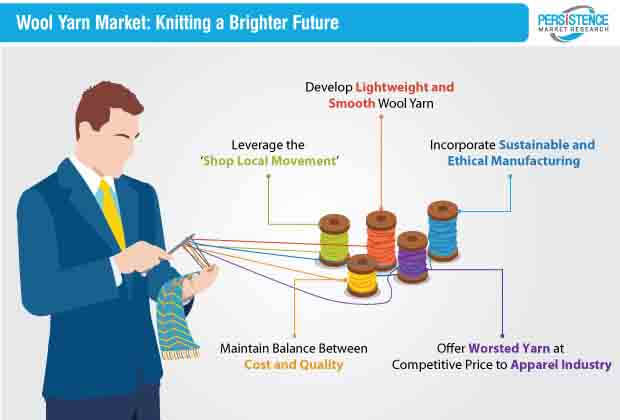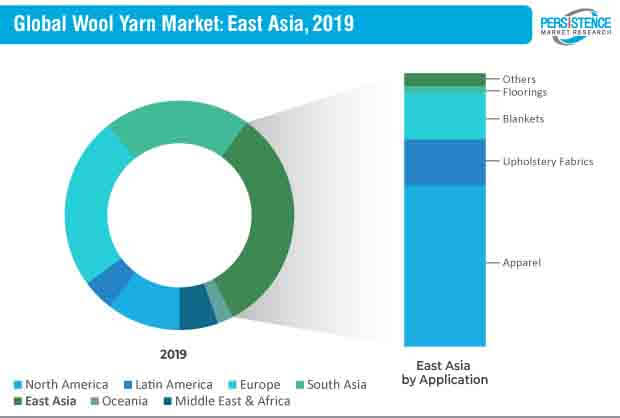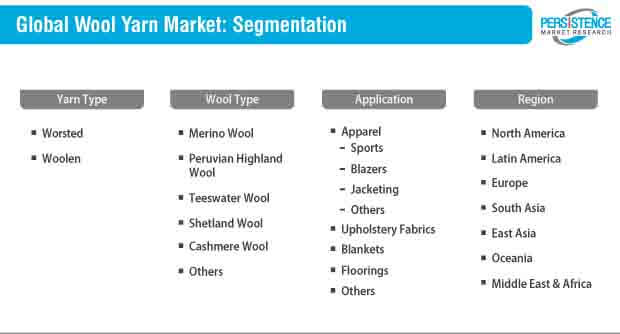Wool Yarn Market Segmented By Worsted, Woolen Yarn Type with Merino Wool, Teeswater Wool, Peruvian Highland Wool, Shetland Wool, Cashmere Wool Type for Apparel, Upholstery Fabrics, Blankets, Flooring
Industry: Chemicals and Materials
Published Date: June-2019
Format: PPT*, PDF, EXCEL
Delivery Timelines: Contact Sales
Number of Pages: 263
Report ID: PMRREP29236
End users in the textile industry are developing a proclivity for high-quality wool, and the competition is getting stronger with higher yields and better styles. The hunt for wool yarn with improved quality and properties, such as lightweight and comfort, continues to raise the bar, not only for manufacturers but also for sheep farmers, to innovate and grow their presence in the textile industry.
In the wool yarn industry, where purebred products translate into the classic and traditional benchmark for wool quality, manufacturers are breaking the rules of the industry by introducing crossbred wool yarns.
The wool yarn landscape is emerging from its chrysalis with crossbreeding, and is opening doors to new opportunities in transseasonal apparel and a wider range of other applications.
The expansion of scope for innovation underscores the potential for crossbred wool yarn in the textile industry, which warrants an exclusive study. Persistence Market Research (PMR) conducted a comprehensive assessment of the future trends and growth prospects of the wool yarn market.
In its latest offering, PMR offers a 360-degree viewpoint on how the future of the wool yarn landscape will shape up through 2019-2029, which can arm decision-makers to build value-based strategies to amplify their gains in the textile and clothing ecosystem.

The year 2019 marks a milestone for wool yarn manufacturers, as the market has not only recovered from a new low during 2014-2018, but has upped to a level where market players can take an attacking stance to boost their sales.
The wood yarn landscape has been sluggish in the past five years, as its valuation plummeted from nearly US$ 49 billion in 2014 to just over US$ 33 billion in 2018.
The growth parameters were mainly affected by the supply-demand imbalance, as demand was upped dramatically, while wool supply remained unchanged until 2018.
The wool yarn market has been reborn to gain stability through the volatility of wool pricing, tariffs & taxation, and dynamic end-user demands, and reach new heights in the coming decade. Manufacturers are likely to shift their focus on joining forces with sheep farmers, to ensure direct access to raw materials, and bank on innovations to boost the quality of wool yarn so as to capitalize on new opportunities in the market.
In addition, leading market players are likely to shift their focus on capitalizing on the increasing growth of the fashion and clothing industry by introducing specific properties in wool yarn to meet the application-specific requirements of their customers.

The textile industry’s penchant for woolen fabrics has expanded the application range for wool yarn, including apparel, upholstery fabrics, blankets, and flooring. In 2018, nearly 50% of the wool yarn sales were attributed to its adoption in apparel, including blazers, jackets, and other types of sports apparel.
The unwavering trend of the growing demand for wool yarn in apparel is expected to shape the salient business strategies of market players in the coming years.
The modern textile industry is shaping up with the emerging trend of adding wool yarn materials in sports apparel, which includes clothing as well as shoes. The sales of wool yarn for the manufacturing of athleisure apparel accounts for nearly half of the sales of wool yarn in the sports apparel industry, and the trend of using wool in athletic shoes is opening new opportunities for wool yarn manufacturers in the sports fashion landscape.
Leading players in the wool yarn landscape are likely to build their upcoming strategies based on the changing trends in the apparel industry and its verticals, as well as dynamic consumer requirements.
The veganism movement is no more bound to the food industry, but has forayed into the textiles and clothing landscape too, triggering tectonic shifts in manufacturers’ strategies in the wool yarn market.
Increasing concerns about animal-cruelty are getting wool yarn manufacturers and retailers into knots, forcing them to take up a cruelty-free approach, coupled with plans to boost the sustainability of the supply chains in this landscape.
Along with strategies to market the breathability and biodegradability of wool yarn, businesses are also putting efforts into promoting their sustainability policies and ethics to establish a new brand image, not only in the wool yarn market but also in its end-use industries.
In a moderately fragmented market such as for wool yarn, leading companies and their competitors hold approximately 65% revenue share of the global market, and emerging players account for the rest of the market share.
Taking into consideration the significant rise in the demand for worsted wool yarn, leading market players are investing heavily in this segment of the market through collaborations and acquisitions, especially in Europe and East Asia.
For instance, in October 2018, Indorama Ventures (IVL) entered into an agreement to acquire the worsted wool yarn business of the Schoeller Group through its indirect subsidiary – Glanzstoff Management GmbH.
In the coming years, small companies and start-ups in regional markets for wool yarn are likely to benefit from the 'shop local' movement adopted in various countries, including the United States and China.
Realizing that outsourcing raw materials to other countries is no longer cost-effective, new entrants in the wool yarn landscape are developing a network of local yarn producers and distributors to gain an edge in the market.

The authors of this study are of the opinion that, the wool yarn market will discern steady growth in the coming years, and its demand will be triggered by the growing applications of innovative fabrics in the apparel industry.
As the textile and clothing ecosystem has been growing at the rate of knots, wool yarn is expected to witness healthy demand in the coming years. However, consumer perception of wool and changing mindset toward animal cruelty will force wool yarn manufacturers to knit themselves a fresh image to survive in this market.
Innovation will remain the key for wool yarn market players to gain a competitive edge in this landscape, where demand for lightweight and smooth fabrics will only grow in the foreseeable future.
Prominence in Apparel and Upholstery Fabric Applications
Favorable Trade Policies and Investments by Governments
Favorable trade policies and production of quality wool yarn are driving textile exports, owing to the growing textile industry. This is expected to create a significant impact on the wool yarn market, as wool yarn is widely consumed in textile production.
Investments made by governments to expand the production of textiles, due to the high demand for wool yarn from the textile industry, are driving market growth.
PMR’s study on the wool yarn market divides information into four broader categories-yarn type, wool type, application, and region. This report offers detailed information about how growth will discern for the wool yarn market, by understanding the influence of important dynamics and growth prospects associated with the aforementioned segments.
| Attribute | Details |
|---|---|
|
Yarn Type |
|
|
Wool Type |
|
|
Application |
|
|
Region |
|
To know more about delivery timeline for this report Contact Sales
